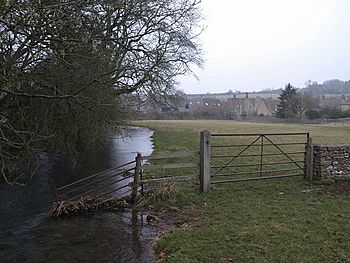River Churn facts for kids
Quick facts for kids River Churn |
|
|---|---|

River Churn near Baunton
|
|
| Country | England |
| Counties | Gloucestershire, Wiltshire |
| Towns | Cirencester, Cricklade |
| Physical characteristics | |
| Main source | Seven Springs 200 m (660 ft) 51°51′04″N 2°03′01″W / 51.8511°N 2.0504°W |
| River mouth | River Thames Cricklade, Wiltshire 79 m (259 ft) 51°38′42″N 1°51′12″W / 51.6450°N 1.8533°W |
| Length | 37.3 km (23.2 mi) |
| Discharge (location 2) |
|
| Discharge (location 3) |
|
| Basin features | |
| River system | River Thames |
The River Churn is a river in central England. It flows into the River Thames. The Churn starts at a place called Seven Springs in Gloucestershire. It then flows south for about 37.3 km (23.2 mi). The Churn joins the Thames near Cricklade in Wiltshire.
Even though the River Churn is longer than the Thames at their meeting point, it is seen as a tributary. A tributary is a smaller river that flows into a larger one.
About the River Churn
The River Churn is the very first river that flows into the River Thames. It begins in the Cotswolds hills. This area is south of Cheltenham in Gloucestershire, England.
The river flows south through the Cotswold dip slope. It passes through towns like North Cerney and Cirencester. Finally, it joins the Thames in the area of Cricklade in Wiltshire.
The Churn is about 37.3 kilometres (23.2 mi) long. It is considered a main river. This means the Environment Agency looks after it, not the local government.
What's in a Name?
The name Churn is very old. It was used even before the Romans came to Britain. It probably comes from a Celtic language. This might have been the language spoken by the Dobunni tribe. They lived in the area before the Romans took over in the 1st century.
The original name might have sounded like Korinn. Some people think the name comes from the ancient British Cornovii tribe. Other similar names in the area are Cerney, Ciren, and Corin. You can see these names in places like North Cerney, Cirencester, South Cerney, and Cerney Wick. All these places are near the river. The old Roman name for Cirencester, Corinium Dobunnorum, also shares this root.
River Churn Through History
The area around the River Churn was very important to the Romans. From the 2nd to the 4th centuries AD, Corinium Dobunnorum (now Cirencester) was likely a capital city in Roman Britain.
The Churn and the Thames help fill the lakes of the Cotswold Water Park. This park was created in the 1970s. It used old gravel pits between Cirencester and Cricklade.
Sometimes, the river can stop flowing completely. For example, in September 2011, the river bed was totally dry in Latton. The government has studied ways to prevent future flooding from the Churn.

